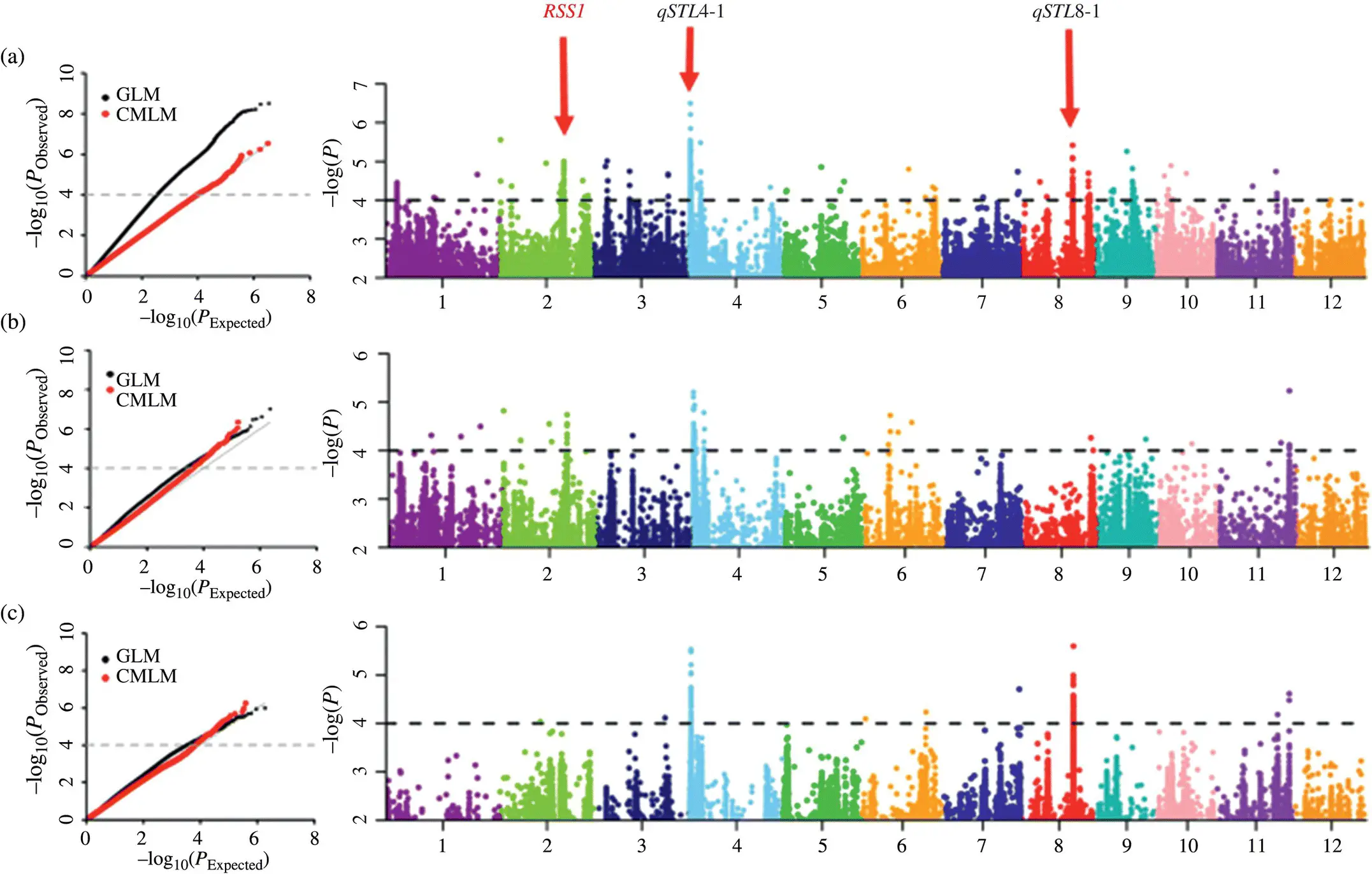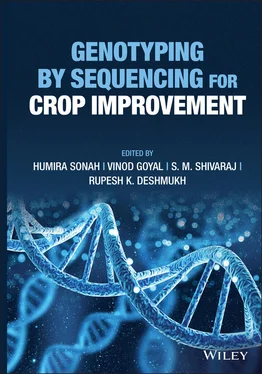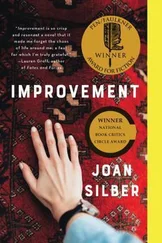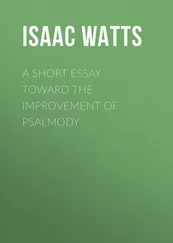Genotyping by Sequencing for Crop Improvement
Здесь есть возможность читать онлайн «Genotyping by Sequencing for Crop Improvement» — ознакомительный отрывок электронной книги совершенно бесплатно, а после прочтения отрывка купить полную версию. В некоторых случаях можно слушать аудио, скачать через торрент в формате fb2 и присутствует краткое содержание. Жанр: unrecognised, на английском языке. Описание произведения, (предисловие) а так же отзывы посетителей доступны на портале библиотеки ЛибКат.
- Название:Genotyping by Sequencing for Crop Improvement
- Автор:
- Жанр:
- Год:неизвестен
- ISBN:нет данных
- Рейтинг книги:4 / 5. Голосов: 1
-
Избранное:Добавить в избранное
- Отзывы:
-
Ваша оценка:
- 80
- 1
- 2
- 3
- 4
- 5
Genotyping by Sequencing for Crop Improvement: краткое содержание, описание и аннотация
Предлагаем к чтению аннотацию, описание, краткое содержание или предисловие (зависит от того, что написал сам автор книги «Genotyping by Sequencing for Crop Improvement»). Если вы не нашли необходимую информацию о книге — напишите в комментариях, мы постараемся отыскать её.
A thoroughly up-to-date exploration of genotyping-by-sequencing technologies and related methods in plant science Genotyping by Sequencing for Crop Improvement,
Genotyping by Sequencing for Crop Improvement
Genotyping by Sequencing for Crop Improvement
Genotyping by Sequencing for Crop Improvement — читать онлайн ознакомительный отрывок
Ниже представлен текст книги, разбитый по страницам. Система сохранения места последней прочитанной страницы, позволяет с удобством читать онлайн бесплатно книгу «Genotyping by Sequencing for Crop Improvement», без необходимости каждый раз заново искать на чём Вы остановились. Поставьте закладку, и сможете в любой момент перейти на страницу, на которой закончили чтение.
Интервал:
Закладка:
For the identification of genetic traits associated with complex traits, genome wide association study (GWAS) has been employed. It helps in the recognition of many SNPs involved with the target trait either by correlation or comparative analysis. Abbai et al. (2019) selected 664 cultivated rice accessions for GWAS from the 3K rice genome. In the case of salt‐tolerant traits, they identified the possible candidate gene and causal polymorphism by performing genetic variation, haplotyping, integrated gene information, and homology analysis. As the precise superior haplotype identification will have a great impact on the molecular breeding outcome. Similarly, Lin et al. (2021) explored weediness‐related traits from the 3K rice genome project in the cultivated pool. They identified weediness‐associated markers by performing GWAS within each subpopulation. One of the examples involved GWAS in rice for the salt‐tolerant trait as shown in Figure 3.2(Yuan et al. 2020). With the help of WGR, it has been possible to construct a high‐quality HapMaps in maize and rice which help to perform GWAS and find unidentified genetic variations of agronomically important traits. The applications of WGR have led to a decrease in the cost of WGS as well as enabled the generation of large data of sequences.
The online resources available for rice, soybean, canola, maize, and wheat are widely being used for the marker development, allele mining, haplotypic evaluation as well as simple applications like gene family characterization (Deshmukh et al. 2016; André et al. 2017; Rasoolizadeh et al. 2018; Chaudhary et al. 2019c; de Ronne et al. 2020; Singh et al. 2019). The free access of resources more particularly in rice and soybean has accelerated basic as well as applied research in these crops.
Apart from the high‐throughput applications, WGR is helpful for specific applications like characterization of varieties developed with marker‐assisted breeding, characterization of introgression lines, and evaluation of transgenic events (Patil et al. 2018; Tayade et al. 2018; Shivaraj et al. 2019). Similarly, resequencing also helps for bulk evaluation‐based approaches like Mut‐Map and QTLseq (Bansal et al. 2019; Chaudhary et al. 2019a; Kumawat et al. 2019). Very recent advancements like genome editing also have implication of WGR (Mushtaq et al. 2019; Vats et al. 2019; Ansari et al. 2020). Mutations at target sites as well as at off‐target can be easily verified with whole‐genome resequencing.
3.8 Challenges for Whole‐Genome Resequencing Studies
Although, various platforms such as Illumina, Roche 454, and SoLiD ™have significantly increased the throughput with a decreased error rate but many plant genomes represent unique challenges because of their repetitive nature which leads to a challenge for reliable genome assembly. This might be due to high copy number and transposable elements amplifying nature in a large number of plants leading to consequences in assembly. Another major constraint is that not all species of plant are homozygous inbred diploids. Currently, there is no WGR technique that meets all conservation geneticists' needs. However, with the advancement in next‐generation sequencing technologies, these challenges can be overcome.

Figure 3.2 Genome‐wide association studies (GWAS) in rice seedling for salt‐tolerant trait. For GWAS, quantile–quantile plots and Manhattan plots are represented for (a) indica, (b) japonica (c) represents population with the help of CMLM. In quantile–quantile plot, black and red points represent GLM and CMLM, respectively. In Manhattan plots, genes represented by red lines were previously cloned while QTLs were represented by black lines, which were considered to be important. The suggestive threshold ( P = 1.0 × 10 −4) for each population is indicated by dashed horizontal line.
The figure is reproduced from Yuan et al. (2020) which is available under a Creative Commons Attribution 4.0 (CC‐By 4.0) International License, which permits reproduction.
3.9 Summary
A new era has been brought in plant genetics with the rapid advancement in NGS technologies. With the help of this, a large amount of data is generated and used in the scientific community. These generated genomic sequences of diverse lines, especially the whole‐genome resequencing aids in the identification of haplotypic/allelic variation. These techniques help in the identification of novel genes and alleles associated with the target genes or traits deployed in the improvement of crops. WGR‐collected genomic data can aid with planning conservation and management of exploited species used commercially by assisting in the delimitation and monitoring of evolutionary units, as well as the prioritizing of endangered populations.
References
1 Abbai, R., Singh, V.K., Nachimuthu, V.V. et al. (2019). Plant Biotechnology Journal 17: 1612–1622.
2 Alexandrov, N., Tai, S., Wang, W. et al. (2015). SNP‐Seek database of SNPs derived from 3000 rice genomes. Nucleic Acids Research 43: D1023–D1027.
3 André, L.L., Sonah, H., Dias, W.P. et al. (2017). Genome‐wide association study for resistance to the southern root‐knot nematode (Meloidogyne incognita) in soybean. Molecular Breeding 37: 148.
4 Ansari, W.A., Chandanshive, S.U., Bhatt, V. et al. (2020). Genome editing in cereals: approaches, applications and challenges. International Journal of Molecular Sciences 21: 4040.
5 Bansal, R., Rana, N., Kumawat, S. et al. (2019). Advances in induced mutagenesis and mutation mapping approaches in rice. Oryza 59: 106–114.
6 Bastide, H., Betancourt, A., Nolte, V. et al. (2013). A genome‐wide, fine‐scale map of natural pigmentation variation in Drosophila melanogaster. PLoS Genet 9: e1003534.
7 Bhat, J.A., Deshmukh, R., Zhao, T. et al. (2020). Harnessing high‐throughput phenotyping and genotyping for enhanced drought tolerance in crop plants. Journal of Biotechnology 324: 248–260.
8 Chaudhary, J., Alisha, A., Bhatt, V. et al. (2019a). Mutation breeding in tomato: advances, applicability and challenges. Plants 8: 128.
9 Chaudhary, J., Khatri, P., Singla, P. et al. (2019b). Advances in omics approaches for abiotic stress tolerance in tomato. Biology 8: 90.
10 Chaudhary, J., Shivaraj, S., Khatri, P. et al. (2019c). Approaches, applicability, and challenges for development of climate‐smart soybean. In: Genomic Designing of Climate‐Smart Oilseed Crops, 1–74. Cham: Springer.
11 Chun‐Chao, W., Yu, H., Huang, J. et al. (2019). Towards a deeper haplotype mining of complex traits in rice with RFGB v2. 0. Plant Biotechnology Journal 18: 14.
12 de Ronne, M., Labbé, C., Lebreton, A. et al. (2020). Integrated QTL mapping, gene expression and nucleotide variation analyses to investigate complex quantitative traits: a case study with the soybean‐Phytophthora sojae interaction. Plant Biotechnology Journal 18: 1492–1494.
13 Deshmukh, R.K., Sonah, H., and Singh, N.K. (2016). Intron gain, a dominant evolutionary process supporting high levels of gene expression in rice. Journal of Plant Biochemistry and Biotechnology 25: 142–146.
14 Fracassetti, M., Griffin, P.C., and Willi, Y. (2015). Validation of pooled whole‐genome re‐sequencing in Arabidopsis lyrata. PLoS One 10: e0140462.
15 Fuentes‐Pardo, A.P. and Ruzzante, D.E. (2017). Whole‐genome sequencing approaches for conservation biology: advantages, limitations and practical recommendations. Molecular Ecology 26: 5369–5406.
16 Goda, S.K. and Minton, N.P. (1995). A simple procedure for gel electrophoresis and northern blotting of RNA. Nucleic Acids Research 23: 3357.
Читать дальшеИнтервал:
Закладка:
Похожие книги на «Genotyping by Sequencing for Crop Improvement»
Представляем Вашему вниманию похожие книги на «Genotyping by Sequencing for Crop Improvement» списком для выбора. Мы отобрали схожую по названию и смыслу литературу в надежде предоставить читателям больше вариантов отыскать новые, интересные, ещё непрочитанные произведения.
Обсуждение, отзывы о книге «Genotyping by Sequencing for Crop Improvement» и просто собственные мнения читателей. Оставьте ваши комментарии, напишите, что Вы думаете о произведении, его смысле или главных героях. Укажите что конкретно понравилось, а что нет, и почему Вы так считаете.












